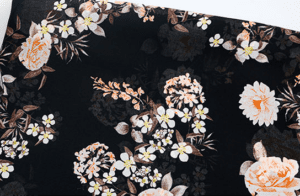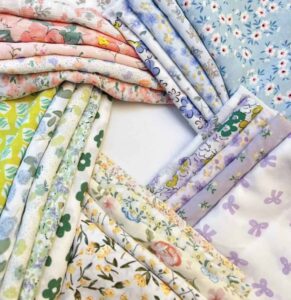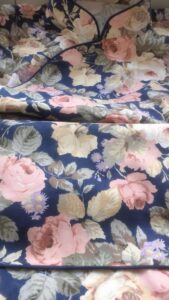Knitted fabrics because of its fabric characteristics, so the operation in the printing production process, necessarily with the woven fabric printing production process, there are relatively large differences and different. Reasonable and correct printing operation is to ensure and improve the quality and yield of knitted fabric printing key.
Sewing head
Woven fabric to prevent the weft slant fault, in the sewing head operation is more effective practice is to tear the head sewing head; and knitted fabric and woven fabric organization structure is different, it is impossible to take the tear head sewing head operation method.
Knitted fabric in order to prevent the weft slant caused by improper head sewing, before the head sewing to do the work is: to see the fabric grain, if necessary, to cut the two heads of cloth along the grain flush. To distinguish the front and back of the fabric, do the front to the front, cut the head of the cloth along the edge of the cloth and then sew the head, and do the head of the sewing to be firm and straight.
Cut width and sewing edge
Woven fabrics produced by the textile factory to embryo are flat, so in the printing and dyeing production process without cutting width and sewing edge; and knitted fabrics are different, its production by the knitting factory to embryo more for the cylinder shape.
In the production process of knitted fabrics, some processing and production processes need fabric flat, such as stretching and shaping, printing, steaming, etc.. Some processing processes need fabric cylindrical, such as knitted fabric pre-treatment, dyeing, flat washing after printing, etc., in order to reduce and prevent knitted fabric yarn damage caused by dispersion rolled edge, as well as the edge of the cloth is not easy to hold.
For this reason, with the knitted fabric production and processing needs to be dissected in due course, the cylindrical knitted fabric dissected into a flat width; and sometimes to the flat width of the knitted fabric or sewing edge into a cylinder, in order to the smooth production. Knitted fabric sectioning is carried out on the sectioning machine.
Pulp edge and cutting edge
Some varieties of knitted fabrics after the width of the specification is easy to produce rolled edge, rolled edge will seriously affect the quality of knitted fabric printing products, affecting the smooth production of printing. To grasp the knitted fabric pulp edge, cutting edge, mainly for those in the production process is easy to produce rolled edge of the knitted fabric. Woven fabrics also have rolled edge of the situation, such as cotton sarka, cotton ammonia elastic fabric in the presence of thick alkali wet and hot conditions, is also more likely to occur in the case of rolled edge, generally through the improvement of fabric edge, pre-shaped and hit the clip and other measures can be resolved.
And knitted fabrics produce rolled edge using the above methods, in the production process can not work, but need to take the pulp edge and remove a small amount of pulp edge outside the useless side of the practice, to ensure that the fabric width uniform, to meet the needs of the printing production. Paste edge generally use non-water-soluble paste. Paste edge width is about lcm, the hardness of the paste edge to moderate. Too hard is sizing too thick, will make the edge of the fabric and the thickness of the fabric difference, affecting the contact surface of the flower network and the fabric surface so that the amount of color printing is not uniform. The mastery of hardness to knitted fabric on the circular screen printing machine does not roll the edge can be, should not be too thick.
Preparation before printing
Knitted fabric printing before the preparation includes two parts:
pre-treatment of knitted fabric printing cloth
Removal of natural and man-made impurities from knitted fabric printing blanks through pre-treatment to provide qualified printing semi-products for knitted fabric printing.
In order to ensure the quality of the printing product and the smooth printing process, the necessary pre-press processing content.
1.knitted fabric pre-treatment, different fiber components to take the pre-treatment process is different.
Synthetic fibers, man-made recycled fibers. Such as polyester, nylon, acrylic, viscose, modal, etc., the fiber texture itself is relatively clean, no need to boil bleaching, bleaching, which is to remove, wash are artificial impurities; such as fabric stained with oil, dust, stains, etc.. Natural fibers such as: cotton, hemp, silk, etc., its growth process along with the growth of fibers at the same time the co-organisms, will affect the printing and dyeing process of these fibers, will affect the performance of these fibers knitted fabrics, these co-organisms are natural impurities must be removed.
In the case of cotton knitted fabrics, the current traditional pre-treatment process after the pre-treatment process is the most important is cooking. Knitted fabrics in the weaving without sizing, so knitted fabric bleaching pre-treatment without desizing process, most of the cotton knitted fabrics are not burned and mercerized.
With the improvement of consumer demand for knitted fabric quality and the development of science and technology production, the production of high-grade knitted products has become a trend, now using yarn burning, mercerization, and then knitted fabric in the printing and dyeing process of fabric burning, mercerization process to improve the luster of knitted fabric color amount, improve the finished grade of knitted products have been in the formation of production batches. In order to improve the brightness of the fabric, reduce the hair of the fabric, in the enterprise without burning hair equipment, some use the method of cellulase to eat hair treatment.
2.knitted fabric printing before preparation
Knitted fabric printing semi-products on the basis of pre-treatment, in order to meet the requirements of printing, to ensure the quality of the product and the smooth production according to the production practice of the generalization, roughly to carry out the following work.
① Pre-printing stenter shaping. To improve the flatness of the semi-product to be printed, improve the dimensional stability of semi-products. Make a good sizing and cutting edge.
② pre-press wefting. Weft slanting fabric semi-products, after printing will form weft slanting defects, can not be repaired. To prevent the production of knitted fabric weft slant defects, before printing must be whole weft.
③ printing embryo whitening. Polyester knitted fabric polyester plus white to be carried out on the stenter shaping machine. Cotton, nylon, acrylic and other whitening can be used to dip in the overflow dyeing machine or dyeing tank.
④ On the anti-static agent. Synthetic fiber knitted fabric in the processing will produce static electricity, adsorption of dust, adsorption of color material and other defects, for this reason to be on the anti-static agent to overcome. On the anti-static agent can be completed in the stenter shaping machine. Polyester knitted fabric on the electrostatic agent can be dipped and dried in the same bath with polyester whitening.
⑤ printing embryo sizing. For some light and easy to wrinkle knitted fabrics need to be sizing, in order to increase the body and bone of knitted fabrics, easy to print.
⑥ printing embryo dyeing bottom. For some need to dye the bottom of the pattern, the knitted fabric semi-products in the pre-press to dye. Dyeing process, the operation is basically the same as the knitted fabric dyeing process operation.
⑦ printing embryo rolled to ensure that the fabric into the cloth tension uniformity, for the yarn is easy to move the light knitted fabrics such as satin, chiffon, silk and other fabrics to be rolled before printing, to facilitate the cloth.
Stenter shaping
Stenter shaping can be divided into embryo stenter shaping, pre-press stenter shaping, finished product stenter shaping and other types. The arrangement and number of shaping should be determined according to whether the production quality requirements can be ensured and whether it is conducive to smooth production.
The above several stenter shaping processing purposes and advantages and disadvantages are briefly described as follows.
(1) embroidery cloth amplitude deformation that is the knitted fabric embroidery cloth stenter deformation. The advantage of this stenter shaping is that the fabric can be processed in the subsequent processing to reduce the occurrence of serious deformation. Clear the knitted fabric in the weaving process, due to the strong role of stretching deformation and the existence of residual tension.
For elastic knitted fabrics can prevent shrinkage in the pre-treatment wet and hot conditions, reduce and overcome the generation of wrinkles. However, the process requires that the incoming embryo is clean and cannot contain impurities that become difficult to remove after the high temperature treatment. Embryo stentering and shaping yield increases with the development of knitted fabrics containing spandex fiber.
(2) pre-printing stenter shaping, that is, knitted fabric printing cloth after pretreatment is about to print before the stenter shaping. Through this process to achieve fabric wrinkle, so that the fabric flat size stability. And at the same time the fabric can be sizing, cutting edge, whitening, on the anti-static agent and so on to ensure the smooth production of printing.
Prevent fabric deformation measures when printing
Knitted fabric structure characteristics loose, easy to deformation in the printing production process by the tension warp easy to become longer, weft narrowing. Fabric deformation in the printing will bring a series of problems, resulting in weft slant. Crease and the printing process of the printing process of printing defects. Therefore, in the printing machine printing to prevent and overcome the resulting series of problems, is to ensure the quality of knitted fabric printing and ensure the smooth printing of knitted fabric key issues.
There are considerable printing and dyeing enterprises in the production of knitted fabric printing, taking into account this feature of the production of knitted fabric printing and problems, often in a large number of formal production before the test to feel and summarize the knitted fabric in the printing machine warp and weft deformation data and pattern changes, the use of pattern in the description of the appropriate scaling process, such as the pattern longitudinal enlargement, weft reduction approach.
When the knitted fabric in the printing machine printed pattern for the vertical enlargement pattern, weft narrowing pattern, and then in the finishing stenter shape, weft stenter to the finished door width, weft stenter vertical shortening, in order to meet the size of the customer to sample pattern. This approach is not lacking is a kind of approach, but this approach to solve the above problem of knitted fabric printing, can not solve the problem at the root, because the impact of knitted fabric deformation factors are too many, too many variables. Different enterprises have different equipment, each enterprise’s equipment operating conditions are different, the operator’s operating characteristics are not exactly the same.
If the printing of knitted fabrics of a single species using the above approach is still possible, if the printing of a wide variety of knitted fabrics, varying thickness, fabric elasticity, knitted fabric warp and weft scaling, the morphology of the situation is bound to be very different. Such as the use of the above practices that we have to do a wide range of experiments to figure out, to the operation brings a certain degree of difficulty and trouble. In addition, is in the printing of the same species, printing speed, pressure size, fabric tension and other changes will affect the expansion of the fabric, affecting the fabric printing effect.
Knitted fabric in the printing machine printing to ensure the effect of knitted fabric printing, to prevent and overcome the structural characteristics of knitted fabric easy deformation brought about by the series of problems, in addition to practical attention to machine printing, the operation of the adjustment of the stock, to ensure the amount of printing stock penetration, the amount of color, the accurate flower, printing outline clear, but also to grasp the following measures and operations.
(1) the printed knitted fabric in the input printing machine, must be in low tension or tension-free situation, knitted fabric to keep both sides straight input, this one is very important.
(2) The patching fabric must be flat and firmly attached. To choose a good paste, catch a good paste operation, knitted fabric on the machine in the guide tape paste flat suit, paste firmly. This will ensure that the needle fabric in the printing does not move, conducive to the printing process, conducive to the printing effect obtained.
(3) To pay attention to and pay attention to drying equipment, the use of high-capacity jet oven. Require the jet oven has the maximum vapor flow circulation and the highest flow rate to reduce energy consumption. Finish printing the knitted fabric, from the end of the printing table is uncovered and sent into the oven import, by the oven conveyor belt without tension into the oven to complete the fabric drying work, and complete the task of printing.
To do the above measures, in addition to the printing operation to pay attention to the printing machine equipment must also be selected, the use of woven fabric tension into the fabric printing machine printing needle fabric is not easy to obtain satisfactory printing results. As a fabric printing machine in the past, pay more attention to the accuracy of the printing part, the convenience of the operation, the satisfaction of the printing effect, and the choice of knitted fabric printing machine in addition to the above-mentioned attention and attention, but also must pay attention to the printing of knitted fabric into the cloth to low tension, tension-free, to be able to flat absorption paste firm guide belt, the end of the printing and sent to the drying equipment must also be low tension and tension-free, only in the use of equipment suitable for knitted fabric printing and good Operation combined to prevent and overcome the series of problems caused by the easy deformation of knitted fabrics.
Knitted fabric shrinkage generated by the causes and overcome
The shrinkage of cotton knitted fabrics is mainly related to the fiber properties and wet thermal plasticity and knitted fabric structure characteristics and other factors. Knitted fabrics in the printing and dyeing production as well as the weaving production process, there will inevitably be the following situations.
(1) printing and dyeing processing of the hot and humid environment.
(2) in the knitted fabric printing and dyeing production process, has made efforts to create conditions so that the knitted fabric in less tension, tension-free situation, however, so far, the knitted fabric in the processing and production process is not possible to completely avoid tension. The presence of tension makes the fabric longitudinal stretching, fabric density has been reduced, fabric deformation.
(3) Knitted fabrics are dried in a non-stable state.
(4) knitted fabric yarn processing, knitting processing process also exists latent tension.
Due to the existence of the above, will bring to the knitted fabric caused by a series of problems of shrinkage potential, specifically in.
(1) As the dyeing and finishing process is in the wet heat state water molecules into the amorphous area of the fiber, so that the intermolecular chain force is reduced. At this time, under the action of external forces, the molecular chain segments produce displacement, so that the fiber elongation. If dried in this elongated state, hydrogen bonds are formed in the new position between the fiber molecular chains, and the elongated part of the fiber fails to shrink back to its original state. The stability of the deformation in this hot and humid state is not stable.
(2) The knitted fabric is formed by interlocking coils, which has a most stable structural form. If the knitted fabric is in a stable structural form, it is in a dimensionally stable state and does not shrink when exposed to water. However, in the actual production process, the fabric, especially the fabric longitudinal by the larger repeated stretching action, resulting in yarn fiber plastic deformation, fabric longitudinal elongation, width narrowing, coil transfer, fabric structure away from the fabric stable state. This state is unstable, under the appropriate conditions have the tendency to restore the original stable state.
(3) knitted fabric drying in the elongated state, the surface seems to be stable, but in fact this “stability” is temporary.
(4) knitted fabric yarn processing, fabric knitting process by the draft, the impact of tension with latent tension, the same will cause yarn, fiber retraction.
In summary, the causes of knitted fabric shrinkage are.
(1) the return of fiber deformation in the wet and hot state. Cotton knitted fabrics in a relaxed state of washing, water molecules can break the newly generated hydrogen bond, so that the internal stress relaxation, elongation part of the retraction that produced shrinkage.
(2) Knitted fabric deformation of the return. Knitted fabric structure in the case of away from the stable state of knitted fabric, in the wetting and washing, fiber plasticity enhanced, the recovery force has been strengthened, resulting in the return of deformation, elongation retraction, cotton knitted fabric produced shrinkage and return to the original stable state. This is the main reason for the shrinkage of cotton knitted fabrics.
(3) Fiber moisture absorption, yarn diameter increases, resulting in yarn shrinkage caused by shrinkage. Increased yarn diameter causes the length of the yarn to shorten, resulting in fabric shrinkage (including length and width) and increased density.
The above-mentioned is the basic reason for the shrinkage of cotton knitted fabrics. As for the knitted fabric in different circumstances, the impact of shrinkage factors and shrinkage conditions, such as: different fiber composition knitted fabric, different tissue structure of knitted fabric, different dyeing and finishing processes and equipment, whether the fabric after mercerization, stretching shaping and pre-shrinkage treatment, etc., still need to explore the summary of practice, perfect and improve.
Second, to overcome the cotton knitted fabric shrinkage rate of measures and methods
Overcome the problem of cotton knitted fabric shrinkage rate, combined with the knitted fabric printing is in the state of the cut width flat width of the printing characteristics can take the following measures and methods.
(1) Loose processing.
Minimize the tension of each process in the printing and dyeing production process, try to avoid plastic deformation of the fabric in the wet state, to avoid fabric and fiber elongation, which is the most ideal way to prevent fabric shrinkage.
In fact, printing enterprises in the knitted fabric dyeing and finishing processing has taken a lot of loose processing methods, whether from the current knitted fabric printing and pre-treatment finishing equipment selection, are considered loose processing to take a lot of effective loose processing good way. I believe that with the development of knitted fabric printing and knitted printing equipment, knitted fabric loose processing will continue to improve and improve. In addition, in shortening the printing process also in the production of attention and put into production practice, the above measures will be used to reduce the output of knitted fabrics in the wet state plastic deformation, will certainly avoid fabric and fiber elongation, reduce fabric shrinkage is very beneficial.
(2) super-feed drying.
That is, to achieve relaxation drying, reduce the role of tension, so that the fabric tends to be close to the full equilibrium state. In the knitted fabric printing before, overfeed drying can be combined with pre-press stenter shaping process, timely mastering overfeed, and drying the fabric to achieve the purpose of reducing the shrinkage of the fabric.
(3) mechanical pre-shrinkage.
Is the use of special mechanical pre-shrinking equipment on. First, overfeed into the cloth, so that the fabric longitudinal in a relaxed state with room for pre-shrinkage, and then steam to the fabric to give moisture, strengthen the fabric in the relaxed state of plasticity, so that the internal stress of the fabric relaxation, and then through diffusion so that the fabric longitudinal contraction, transverse expansion, or longitudinal extrusion, so that the fabric in the weaving or dyeing and finishing processing of the longitudinal elongation part of the forced retraction. So that the fabric has a relaxed structure, and in this state loose type drying, in order to achieve the effect and purpose of pre-shrinking, mechanical pre-shrinking is to overcome the knitted fabric shrinkage rate is one of the effective measures. The current knitted fabric pre-shrinking machine has for the cylinder knitted fabric, there are also for the flat width knitted fabric. Knitted fabric printing generally only choose to carry out the pre-shrinking machine in the form of cut width flat width.
























